PREVIOUS
17th Lok Sabha
June 13 , 2019
2118 days
20272
0
- Members of the 17th Lok Sabha were elected during the 2019 Indian general election.
- Elections were conducted in 7 phases from 11 April 2019 to 19 May 2019 by the Election Commission of India.

- About 900 million people were eligible to vote and turnout was over 67 per cent – the highest ever as well as the highest participation by women voters.
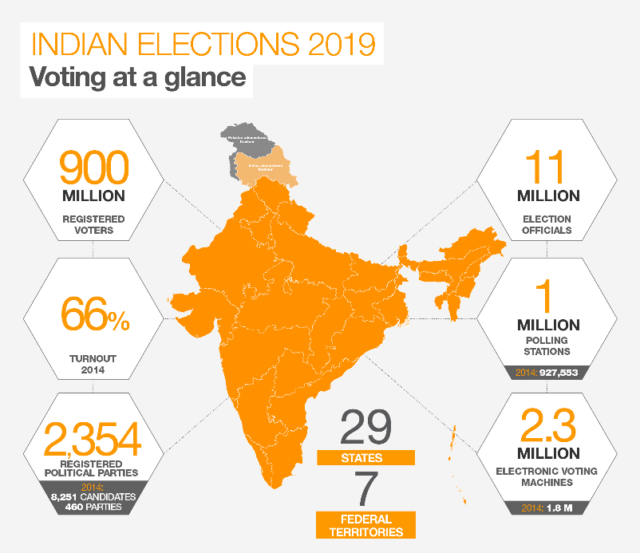
- 10 lakh polling stations were set up this time as against about nine lakhs in 2014.
- ECI guidelines say no voter should be more than 2 km away from a polling station.
- The ‘voter-verifiable paper audit trail’ (VVPAT) was used in all polling stations for the first time.

- The results of EVMs and VVPATs are matched in one polling station per constituency.
- The slip appears on a small window for seven seconds and then drops in a box. The voter cannot take it home.
- In a first, candidates with criminal antecedents will have to publish information in this regard in newspapers and through TV channels on three occasions during the campaign period.
- The Electronic Voting Machines (EVM) and postal ballot papers would for the first time carry the photograph of all the candidates to help voters identify the political leaders in the fray.
- For the first time in India’s electoral history, in 2019 Parliamentary elections the voter turnout for men and women was almost equal.
- 66.79% Men voted and 66.68% women voted in these elections.
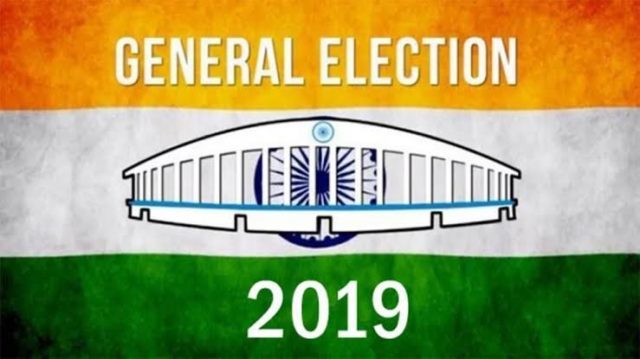
- The Election Commission of India (ECI) submitted a copy of the notification issued by them under the terms of Section 73 of the Representation of People’s Act, 1951 to the President.
- Section 73 deals with the publication of results of General Elections to the House of the People and of names of persons nominated by the President.
- The House or Assembly shall be deemed to be duly constituted after the notification.
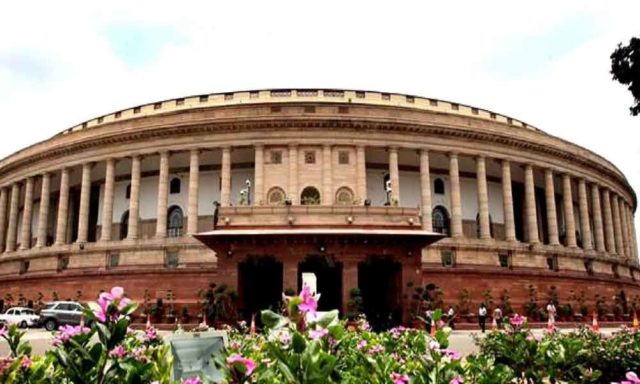
Election Results
- After Jawaharlal Nehru and Indira Gandhi, Narendra Modi is the third prime minister of the country who has been able to retain power for a second term with full majority in Lok Sabha.
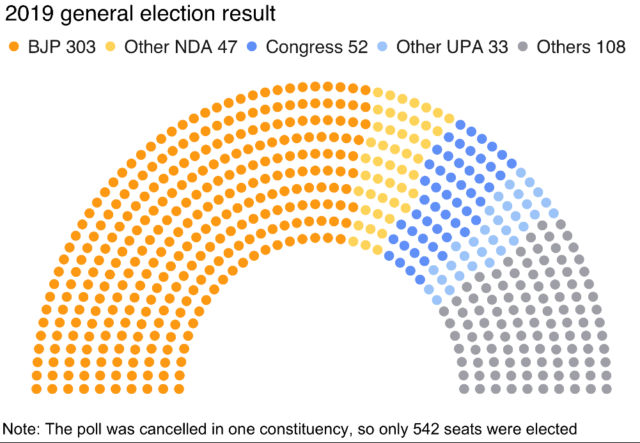
- The BJP has seen its vote share soar past 50 per cent in at least 13 states and Union territories, a feat which the rival Congress could manage only in Puducherry.
- The party has got close to 50 per cent in Uttar Pradesh and even higher in Haryana, Madhya Pradesh, Rajasthan, Chhattisgarh, Uttarakhand, Gujarat, Jharkhand, Himachal Pradesh, Goa, Karnataka, Delhi, Chandigarh and Arunachal Pradesh.
- The BJP's total vote share stood at 37.4 per cent, an increase of over 6 percentage points from 31.34 per cent in 2014.
- The National Democratic Alliance secured a vote share of 45 per cent, compared to 38 per cent in 2014.
- In contrast, the vote share of Indian National Congress remained the same at 19.5 per cent.
- About 1.04 percent of the voters in India chose to vote for None of The Above (NOTA), with Bihar leading with 2.08 percent NOTA voters.
- Bihar alone saw about 8.17 lakh voters opting for the None of The Above (NOTA) option - the highest in the country.
- The Congress has drawn a blank in 18 states and Union Territories -- an indicator of its decimation in the Lok Sabha polls.
- The Congress has been completely routed in Andhra Pradesh, Arunachal Pradesh, Chandigarh, Dadar and Nagar Haveli, Daman and Diu, Gujarat, Haryana, Himachal Pradesh, Jammu and Kashmir, Lakshadweep, Manipur, Mizoram, Nagaland, Delhi, Rajasthan, Sikkim, Tripura and Uttarakhand.
- Four independent candidates have made it to the Lok Sabha this time compared to three during the previous general elections in 2014.
- The highest number of winning independent candidates was seen in 1957, when they bagged 42 seats, followed by 37 in 1952.
- With a strength of 303, the BJP is all set to have the highest number of MPs.
- The winning coalition National Democratic Alliance, alias NDA, consisting of 16 parties, captured 358 seats out of 545 seats.
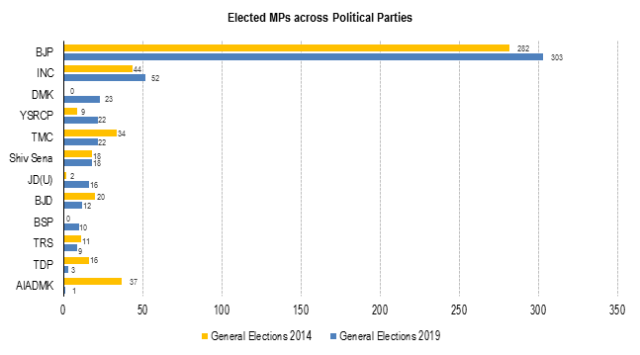
- The Indian National Congress party won 52 seats, and the Congress-led United Progressive Alliance won 91. Other parties and their alliances won 98 seats.
- 397 MPs were elected from national parties. Of these 303 MPs were from BJP, 52 from Congress, and 22 from TMC.
- Among the state parties DMK (23) and YSRCP (22) won the most seats.
- Like 2014, there will be no Leader of the Opposition in the House this time too.
- The requirement for that is that the largest Opposition party should have won at least 10% of the seats (55).
Special Facts
- 267 MPs will be in Lok Sabha for their first term.
- From the outgoing Lok Sabha, 230 MPs were re-elected.
- Further, 45 have been members of earlier Lok Sabha.
- 43% of the Lok Sabha have declared criminal cases against themselves.
- This is an increase of 44% as compared to the MPs with criminal cases since 2009.
- 475 members in the new Lok Sabha are 'crorepatis'. The average assets of winners in the Lok Sabha elections is ₹9 crore.
- The average age of an MP is 54 years.
- It has 12% of MPs below the age 40 years.
- 716 women candidates contested this Election.
- Out of which, 78 women MPs have been elected with Uttar Pradesh and West Bengal leading at 11 each.
- This comprises 14.6% of the total strength of the Lower House.

- In 2014, 62 women MPs were elected.
- The representation of women MPs in Lok Sabha is slowly improving from 5% in the 1st Lok Sabha to 14 % of the present.
- This time is the highest number of women representatives.

- Though the percentage of women MPs has increased over the yearsin our Lok Sabha, it is still lower in comparison to some countries. These include Rwanda (61%), South Africa (43%), UK (32%), USA (24%), Bangladesh (21%).
- A woman of tribal community, Chandrani Murmu has made history after winning the Lok Sabha seat from Keonjhar in Odisha.
- She has become the youngest Member of Parliament (MP) at the age of 25 years and 11 months.
Caste and Religion
- Overall, more than 90 percent MPs in the 17th Lok Sabha are Hindus primarily due to 99.6 percent of the BJP members are Hindus.

- Muslims MPs have improved their number from 23 to 27 in this Lok Sabha.
Education and occupation
- In terms of educational qualifications, about 67% of MPs are graduates or postgraduates, while 4% are doctorates.
- 27% of MPs have studied till 12th class.
- Around 394 MPs have at least Graduate level education.

- 39% of MPs have listed their profession as political and social work.
- The second most common profession listed was agriculture, while 23% were involved in the business.
- Of the 542 elected MPs, the BJP's Sadhvi Pragya Singh Thakur perhaps has the most interesting profession according to her affidavit to the Election Commission, she is a "beggar".
Swearing ceremony
- India has invited the leaders of the BIMSTEC Member States for the swearing-in ceremony of Prime Minister Narendra Modi.
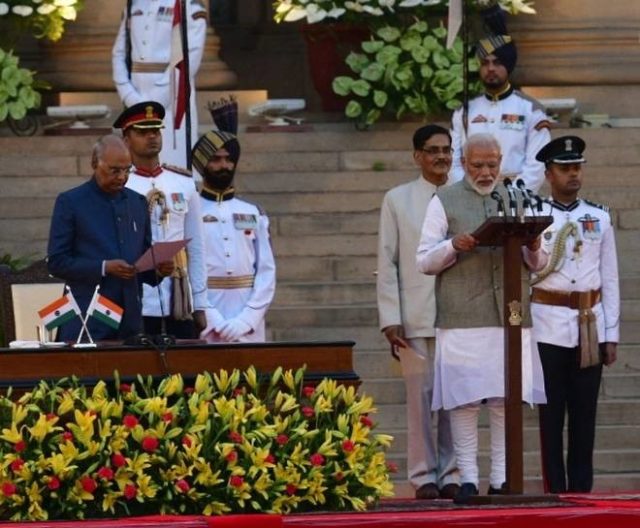
- In 2014 India had invited SAARC leaders to the swearing in ceremony.
Some Previous Election’s facts
- In the 2014 Lok Sabha polls, Voter-verified Paper Audit Trails (VVPATs) were used in eight constituencies.
- In Lok Sabha elections, the None of the Above or NOTA option was first used in 2014 in all constituencies.
- The first Lok Sabha elections were contested for 489 seats. The number of constituencies was increased to 543 in 1977.
- In the 2009 general election, the ECI set up a polling station in the Gir forest of Gujarat, home to Asiatic lions, just for one voter.
- The EC said India had gone to polls with photo electoral rolls for the first time in 2009.
- - - - - - - - - - - - - - -
Leave a Reply
Your Comment is awaiting moderation.


